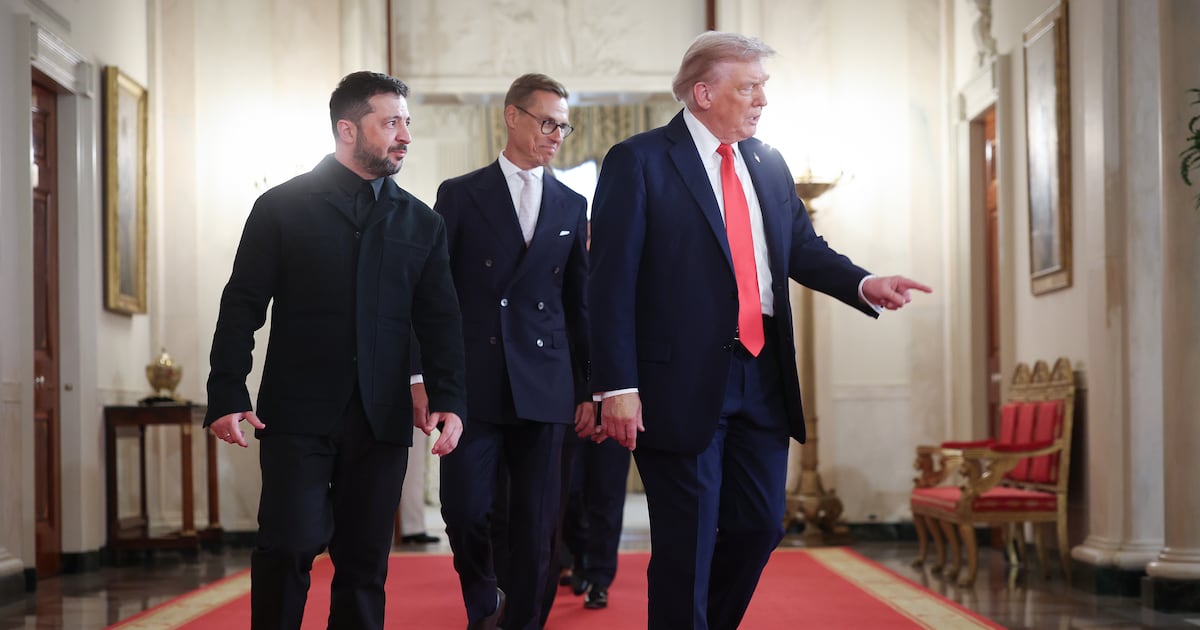Finland’s president, Alexander Stubb, can play a tidy round of golf, something that has suddenly become very useful in a world where everything can turn on a leader’s rapport with Donald Trump.
Stubb, an unknown entity on the world stage, struck up a good relationship with the US president when the pair played a round together at his Florida golf club in March.
Republican senator Lindsey Graham reportedly lined up the game, where Stubb had an opportunity to chat with Trump about the Ukraine war among other things.
Given Finland shares a 1,340km border with Russia, Stubb can speak with authority about Russian president Vladimir Putin.
The Finnish politician stayed in regular contact with Trump afterwards, which has seen Stubb emerge as an unlikely back channel from Europe to Washington.
So Stubb found himself sitting around the table with Trump this week in the White House, alongside the leaders of France, Germany, the UK, Italy, along with Ukrainian president Volodymyr Zelenskiy, Nato secretary general Mark Rutte and European Commission president Ursula von der Leyen.
We are seven months into Trump’s second term and European leaders may be starting to feel like they are getting a slightly better handle on how to work the US president.
Trump’s thinking on the Ukraine war – sometimes influenced by the last person he discusses the subject with – has swung back one way and then another in that time.
Europe remains anxious about the terms of any potential settlement in the full-scale conflict, which started more than three years ago when Russia invaded Ukraine.
Fears Putin would use a summit in Alaska to manoeuvre Trump into supporting a peace deal that favoured Russia, as the price of a quick win, did not come to pass.
However, Trump came out of the face-to-face with Putin colder on previous threats of further sanctions on Russia and his demands for an unconditional temporary ceasefire to let peace negotiations begin.
There was a feeling Zelenskiy and the accompanying delegation of European leaders came away from their own sit-down with Trump this week relatively happy.
The feedback during “debrief” video calls with a much wider group of European leaders the day after was that the White House visit went well, according to one source with knowledge of what was said.
In what could prove to be an important shift in position, Trump signalled support for Ukraine’s future security being guaranteed by European allies in “co-ordination” with the US.
Ukraine has long sought commitments that the US and other allies would provide security guarantees to put Putin off the idea of any future attack in the event of a long-term truce.
The Baltics and others close to Russia view any deal that undermines Ukraine’s sovereignty as an invitation to Putin to make another attempt on Kyiv a few years down the line, then possibly attack an EU state.
One Kyiv-based diplomat said the idea of Ukraine conceding some eastern territory held by Russian forces was not as controversial domestically as before, but should only happen as part of a final deal rather than a condition to open talks.
Europe seems to have settled on its team of Trump whisperers, tasked with nudging the US president to come down on the side of Ukraine’s view of the conflict.
Stubb is in there. UK prime minister Keir Starmer and Nato chief Rutte as well, having both been very careful to stay on Trump’s good side. Rutte got on well with Trump during the US president’s first term, when Rutte was Dutch prime minister.
French president Emmanuel Macron has done a good job of maintaining a decent relationship, while at times criticising the new US administration. Trump clearly has a soft spot for Italy’s hard-right prime minister Giorgia Meloni, who is the closest of the bunch to himself ideologically.
A few months ago the head of the EU’s executive arm, Von der Leyen, seemingly couldn’t get a phone call with Trump, never mind a meeting. The rapport between the two seemed warmer this week.
Trump enjoyed referring to the EU-US tariff agreement the pair struck as the “largest trade deal in history”. Mind you, he should be happy about it, given how favourable it is to the US.
The European strategy is to paint Putin as the real obstacle to Trump getting his desired peace deal. That would hopefully lock in vital US support for Ukraine, should Russia not take current talks seriously and the war rages on.
High-stakes negotiations between Putin and Zelenskiy, and perhaps Trump, about a possible end to the fighting suddenly look a lot more likely. Should they happen then Europe will need to lean heavily on its leaders who have managed to establish a direct line to Trump to make sure what emerges is not peace on the Kremlin’s terms.
